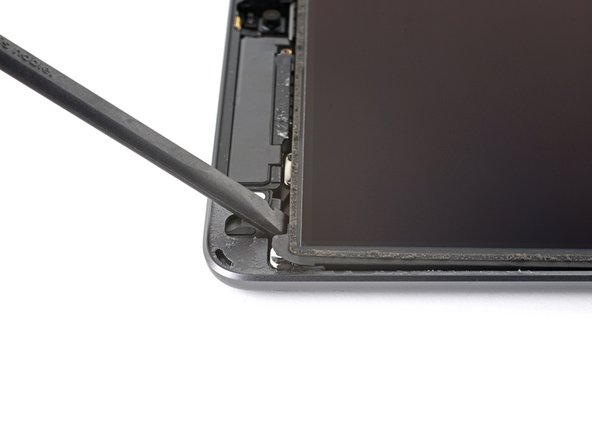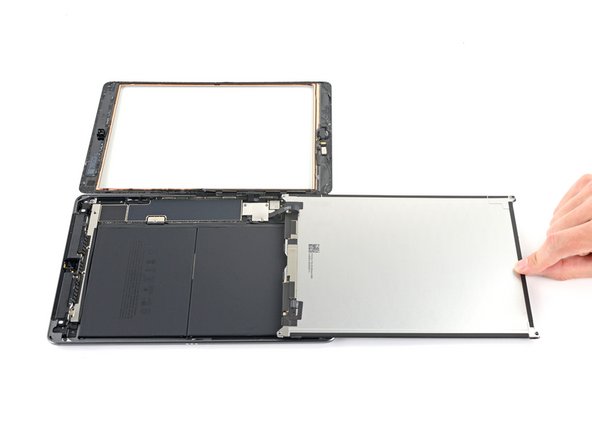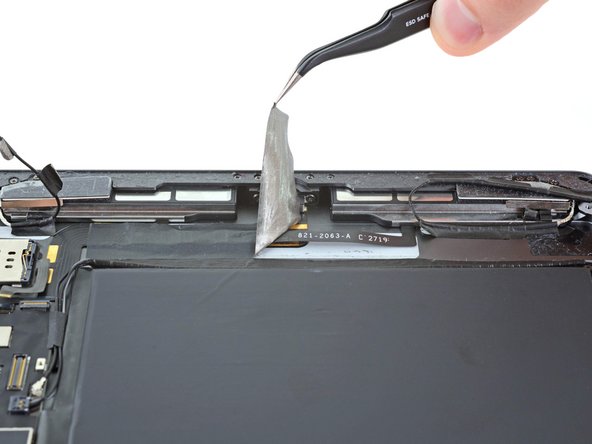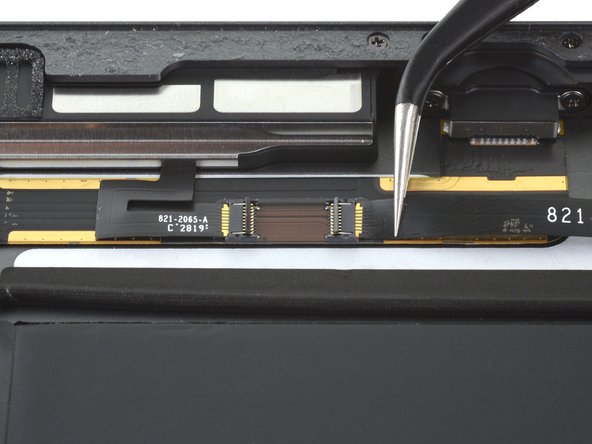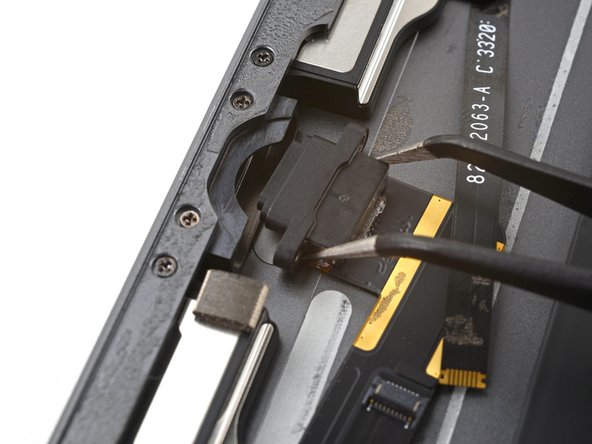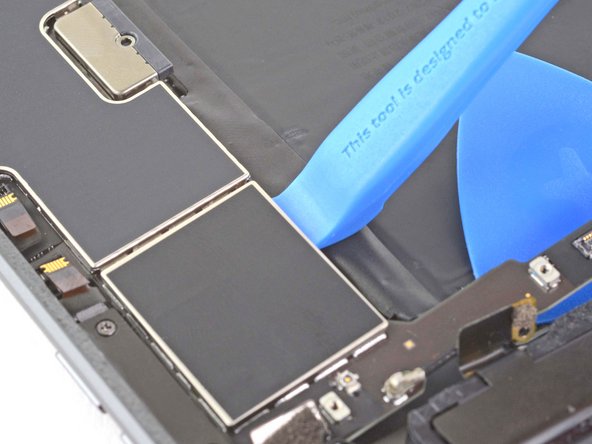iPad 9 LTE Battery Replacement
Duration: 45 minutes
Steps: 128 Steps
Before you start taking apart your iPad, make sure the battery is drained below 25%—better safe than sorry!
Ready to swap out your iPad 9 LTE's battery? Great choice! This guide is specifically for the LTE model—if you've got the Wi-Fi version, you’ll want to check out the other guide. Before you dive in, make sure to drain the battery below 25%—it’s a safety thing, reducing the risk of fire if anything goes wrong during the repair. If your battery’s looking a little puffy, take extra care. And when you're isolating the battery, use the battery blocker with caution—those contacts are delicate, and you don’t want to cause any irreversible damage. If you prefer skipping the battery isolation, just steer clear of metal tools unless necessary (like for screws) to avoid shorting the battery or messing with the circuit components. A heads up: some of the images might be from a different model, but no worries—they won’t mess with your repair process. Need a hand? If you hit a tough spot, just schedule a repair.
Step 1
- Grab a SIM eject tool, a bit, or even a straightened paper clip and slide it gently into the SIM card tray hole.
- Give a little push to the tool and watch as the SIM card tray pops right out.
- Carefully pull out the SIM card tray and set it aside, ready for the next step.
Step 2
Kick things off by powering down your iPad before we dive into the repair.
- Heat up your trusty iOpener and gently press it to the left edge of your iPad for about two minutes. Let the heat do its thing and work its magic. Patience is key, but you’ve got this!
Tools Used
Step 3
- Hey, while that adhesive is chilling out and loosening up, keep an eye on these spots that can be a bit finicky to pry:
- Front camera
- Ambient light sensors
- Antennas
- Display cables
Step 4
The next three steps will show you how to use the Anti-Clamp, a nifty tool we designed to make opening your device a breeze. If you're not using it, no worries! Just skip ahead three steps for another method.
For a full walkthrough on how to use the Anti-Clamp, check out this guide.
If the surface of your iPad is too slippery for the Anti-Clamp to get a good grip, just tape it up! A little extra texture goes a long way.
- Grab the blue handle and pull it back to unlock the Anti-Clamp's arms. Easy, right?
- Place something soft under your iPad so it stays nice and level between the suction cups.
- Now, position the suction cups near the middle of the left edge—one on top, one on the bottom. Precision is key!
- Hold the bottom of the Anti-Clamp steady and gently press down on the top cup to apply that suction. Feel the grip!
Step 5
- Gently pull the blue handle forward to lock those arms in place.
- Twist the handle clockwise a full 360 degrees, or keep going until the suction cups start stretching.
- Make sure the suction cups stay nice and aligned. If they start to drift out of sync, just loosen them up a bit and realign the arms.
Step 6
Take it easy—crank no more than half a turn at a time, and pause for a minute between twists. Let the Anti-Clamp and time do the magic.
Looking for a step-by-step on how to use your hair dryer for repairs? We've got you covered right here in this handy guide.
If the Anti-Clamp isn't giving you enough wiggle room, just crank it up a notch—apply some more heat and give that handle a little twist clockwise to get the gap you need.
- Take a minute to let the adhesive do its thing and create a little opening gap.
- If the screen’s not getting warm enough, give the left edge of your iPad a little TLC with a hair dryer.
- Slip an opening pick under the digitizer once the Anti-Clamp has worked its magic and left a nice gap.
- Feel free to skip the next step!
Step 7
If your display is seriously cracked, slap on some clear packing tape to help the suction cup stick. Or swap in some heavy-duty tape instead. If nothing's working, superglue that suction cup right to the screen. If you're not feeling super confident, you can always schedule a repair.
- Once the screen is comfortably warm to the touch, grab your suction handle and place it on the left edge of the screen, as close to the edge as you can manage.
- Gently pull the screen using the suction handle to create a little gap between the digitizer and the frame.
- Slip an opening pick into that gap between the digitizer and the frame, and you're off to the next step!
Tools Used
Step 8
No worries if the opening pick is peeking through the digitizer—just pull it out. The LCD screen should be just fine, but you might end up with some stubborn adhesive that’s a bit tricky to clean. Take your time and keep it neat!
- Pop another opening pick into that gap you just made.
- Slide the pick toward the bottom-left corner of the iPad to loosen the adhesive.
- Leave the pick in the bottom-left corner to keep the adhesive from re-sticking.
Step 9
- If your opening pick gets caught in the adhesive, just roll it along the side of the iPad to keep separating the bond.
Step 10
- Slide the first opening pick up towards the top-left corner of your iPad to loosen the adhesive.
- Keep the pick parked in the top-left corner to stop the adhesive from re-sticking.
Step 11
- Warm up your iOpener and gently apply it to the top edge of the iPad for two minutes—let's get that heat working its magic!
Tools Used
Step 12
Be gentle when inserting the pick—just slide it up to 7 mm to keep that ambient light sensor safe and sound!
- Gently work the pick around the top-left corner of the iPad to carefully peel away the adhesive.
Step 13
Keep the pick away from the front camera lens to avoid any oops moments—this next part will show you how to keep it safe and sound.
- Gently slide the opening pick along the top edge of the iPad, stopping just before you hit the front camera.
Step 14
- Gently pull the pick so just the tip is snug between the digitizer and the frame.
- Slide the pick carefully above the front camera to loosen the adhesive.
- Leave the pick resting near the right side of the front camera before moving forward.
Step 15
- Grab the pick again and slide it towards the top-right corner of the iPad. This will help you fully separate the top adhesive.
- Leave the pick in that top-right corner to stop the adhesive from sealing back up.
Step 16
- Warm up your iOpener and give it a two-minute spa treatment on the right edge of your iPad. This will loosen things up nicely and make your job a whole lot easier.
Tools Used
Step 17
Ease that pick in, but keep it under 4 mm to keep the ambient light sensor happy and intact!
- Gently rotate the pick around the top-right corner of your iPad to carefully separate the adhesive. Take it slow and steady, and you'll be all set!
Step 18
The display cables are chilling about halfway up from the bottom of the iPad. Slide carefully until you're three inches from the bottom and pause there.
- Grab your new opening pick and carefully slide it down to the middle of the iPad's right edge.
Step 19
- Warm up an iOpener and gently press it to the bottom edge of the iPad for about two minutes. Let the heat work its magic to soften things up before moving on.
Tools Used
Step 20
Be careful not to rotate the pick all the way around the corner—it could end up damaging the antenna. Go slow and steady to avoid any mishaps.
Take a look at the third image – it shows the bottom-left antenna tucked right underneath the digitizer. It's like the little hidden hero of your device!
- Gently slide the bottom-left pick into the corner to start loosening that sticky adhesive.
- Once the pick is in place, leave it there for now before moving on to the next step.
Step 21
Make sure to slide the pick gently towards the home button, not away from it—moving it the other way could cause some damage to the antenna.
If you need to glide the pick across this spot again, just pull it out and re-insert it starting from the bottom-left corner.
- Slip a new opening pick into that gap you just created on the bottom edge of the iPad.
- Slide the pick over the antenna, stopping right before the home button.
- Leave the pick hanging out to the left of the home button before moving on.
Step 22
- Pop that opening pick into the gap you've just made.
- Now, slide the pick under the home button, aiming for the bottom-right corner, and keep only the tip snug between the digitizer and the frame.
Step 23
Slide that pick straight toward the home button—steer clear of going the other way, or you could mess up the antenna!
If you gotta glide that pick over this part again, just pull it out and slip it back in at the bottom-right corner.
- Slip the pick back in and glide it toward the home button to fully detach that bottom adhesive.
- Keep the pick parked to the right of the home button before you proceed.
Step 24
- Warm up your iOpener and give the right edge of the iPad a nice, steady hug for two minutes – let's get that adhesive loosened up!
Tools Used
Step 25
Take it slow here! Make sure the adhesive is nice and warm, and don’t rush it. Use your opening pick to carefully separate all the adhesive. It’s okay to pause and give it a reheat if you need to — no stress!
If you hit some stubborn resistance, just warm up the edges a bit more and gently wiggle an opening pick along them to ease things open.
- Gently twist the two opening picks at the left corners of your iPad. This will help lift the digitizer just enough to break the last of that stubborn adhesive. It's like giving it a little nudge to help it wake up!
Step 26
- Gently lift the left edge of the digitizer, giving a little extra wiggle to peel away the adhesive along the right edge of your iPad. Take it slow, the adhesive doesn't stand a chance!
Step 27
Watch out for those two display cables—let's not let your opening pick turn this into a cable-cutting party!
- Gently support the digitizer and slide an opening pick between the display cables to loosen the last bit of adhesive. Take your time here—patience pays off!
Step 28
- Once you've peeled away all that adhesive, flip the digitizer open like a well-thumbed book and lay it flat next to your iPad.
- When it's time to put everything back together, wipe off the leftover adhesive from the frame—and the digitizer if you're reusing it—with some isopropyl alcohol. Then, refresh with our adhesive strips or pre-cut cards.
- Keep those display cables in mind during reassembly—fold them neatly under the LCD screen to dodge any potential damage.
Step 29
- Grab your tweezers or just use your fingers to peel away any tape hiding the LCD screws.
Tools Used
Step 30
- Grab your trusty Phillips #00 screwdriver and carefully unscrew the four 4.2 mm screws holding the LCD screen in place.
Tools Used
Step 31
The LCD is gently sticking to the frame. A little patience and a careful hand should do the trick!
- Slide a spudger gently between the frame and the top-right corner of the LCD.
- Carefully pry with the spudger to loosen the adhesive without rushing.
Tools Used
Step 32
- Now, go ahead and do the same thing for the top-left corner of the LCD. You got this!
Step 33
Don't try to pull out the LCD just yet—it's still hanging on by a flex cable. Be gentle!
- Grab your spudger and gently use the flat end to ease the LCD out of its snug spot just enough so you can get a good grip on it with your fingers.
- Now, flip that LCD like you're turning a page in a book—lift it near the camera and slowly roll it over towards the home button end of the frame.
- Set your LCD down on a nice, clean, soft surface—make sure it's lint-free so those display cables are easy to access.
Tools Used
Step 34
- Grab your Phillips screwdriver and twist out that 2.3 mm-long screw holding the battery connector to the logic board.
Step 35
Check out these pics showing the battery connector under the logic board. Use them as a handy reference while you safely unplug the battery.
Spot those cantilever springs on the logic board? They press against the battery contact pads. Since the board and battery are glued down, gently slide a thin, flexible tool between the contacts to disconnect it.
Step 36
Take it easy when isolating the battery with a blocker. The battery contacts are a bit delicate, and a tiny slip can cause some serious, permanent damage. Handle with care!
Double-check that the logo on your battery blocker is facing up – orientation is key!
Ease that battery blocker under the connector gently, no need to force it. If it's not fitting smoothly under the logic board, grab a playing card instead to disconnect the battery – it'll do the trick!
Your battery blocker or playing card should slide under the logic board without any snags. Once it's in, let it rest at about a 15-degree angle for that sweet spot.
- Gently slide the battery blocker under the logic board's battery connector at a 35-degree angle. Think of it like sliding a secret note into a locker—smooth and careful.
- Once it's in place, leave the battery blocker there while you continue your work. It’s got your back now, so no need to rush.
Tools Used
Step 37
- Grab your Phillips screwdriver and carefully remove the three 1.4 mm screws holding the display cable bracket in place.
Step 38
- Carefully lift off the display cable bracket – got it!
Step 39
- Grab a spudger and use the flat end to gently pry up and disconnect that LCD cable press connector. Take it slow, no need to rush here!
- When it's time to re-attach, carefully line up the connector and press down one side first until you hear that satisfying click. Then do the same on the other side. Skip pressing the middle—it’s like the secret to making sure those pins stay nice and straight. If you mess it up, those pins might bend, and that’s a one-way ticket to damage town.
Tools Used
Step 40
- Gently remove the entire LCD and place it face-down on a clean, soft, lint-free surface to keep things safe and smooth.
Step 41
- Snag your tweezers and carefully peel back the tape on the home button cable ZIF connector—you're doing great!
Tools Used
Step 42
- Grab a spudger, an opening tool, or just your fingernail to gently flip up the tiny, hinged locking flap on the home button cable ZIF connector. Easy does it!
Tools Used
Step 43
- Grab your tweezers and gently tug that home button ribbon cable right out of the ZIF connector – keep it nice and straight!
Tools Used
Step 44
Be gentle and pry only on the connectors themselves—not on the socket on the logic board—to keep your iPad safe and sound.
- Grab the flat end of your spudger and gently pry up those two digitizer cable connectors to disconnect them.
Tools Used
Step 45
Be super careful not to damage the home button ribbon cable – it's delicate, and a little mishap could cause some headaches down the line.
- Take the flat end of your trusty spudger and gently lift up the buffer block hanging out near the bottom-right corner of your iPad.
- Carefully pull out that buffer block and set it aside.
Tools Used
Step 46
The home button cable is tucked in with a touch of light adhesive – easy to handle!
- Grab your trusty tweezers and gently peel the home button cable away from the frame – you've got this!
Tools Used
Step 47
Grab your opening pick and carefully slice away any leftover adhesive still gluing the front panel to the frame.
Without the right insulation, these digitizer spots might short-circuit against other parts, messing up your touch inputs.
This insulation's stealthy—totally invisible to the naked eye—and it's not the same as those foam dust barriers on some iPads.
- First things first, remove the front panel assembly. It’s like peeling back the layers of a mystery.
- If you’re noticing any weird ‘ghost’ touches or phantom inputs on the new display, no worries! Just add a super-thin layer of insulating tape (Kapton tape works great) on the marked spots at the back of the panel. Don’t stress though, if you’re using a replacement screen from Salvation Repair, it should already have the right insulation, so you won’t need to add tape.
- When you're getting ready to reassemble, make sure to clear off any old adhesive from your device. Grab some high-concentration isopropyl alcohol (90% or more) and a lint-free cloth to clean up the glued areas. This step is crucial to get that fresh adhesive to stick properly.
- Before you seal everything back up, test the iPad’s functions to make sure it’s all good. Then, use pre-cut adhesive strips on the back of the display, and follow the adhesive application guide for the perfect finish.
Step 48
- Hey, let's gently peel that LCD buffer tape from the upper component bracket – take it slow and steady!
Step 49
- Grab a Phillips #00 screwdriver and unscrew the five screws holding that upper component bracket in place:
- Three screws, each 1.4 mm long
- Two screws, each 1.9 mm long
Tools Used
Step 50
- Grab the pointed end of your trusty spudger and gently pry up that upper component bracket until you can snag it with your fingers.
Tools Used
Step 51
- Gently peel back the upper component bracket with your fingers, like you're uncovering a hidden treasure.
- Carefully remove the upper component bracket, just like lifting a lid off a box.
Step 52
- Carefully peel away any tape that's covering the left ambient light sensor's ZIF connector—you're doing great!
Step 53
- Grab a spudger, opening tool, or your trusty fingernail and gently lift the small, hinged flap on the left ambient light sensor's ZIF connector. It’s just a quick flip—nothing too tricky here!
Tools Used
Step 54
- Grab your tweezers and gently wiggle the left ambient light sensor cable straight out of the ZIF connector—think of it like a smooth dance move, no sudden jerks!
Tools Used
Step 55
The left ambient light sensor is gently stuck to the frame, so take it easy when prying it loose.
- Gently grab the sensor with your tweezers (or just use your fingers if you're feeling extra confident) and carefully lift it out of the frame.
Tools Used
Step 56
- Snag your tweezers and gently pluck out any leftover adhesive on the frame – you're doing great!
Tools Used
Step 57
- Gently peel back any tape that's covering the headphone jack's press connector. You're almost there!
Step 58
- Grab the flat end of your spudger and gently pry up to disconnect the headphone jack's press connector.
Tools Used
Step 59
The headphone jack cable is lightly stuck to the frame with some adhesive.
- Grab tweezers or your fingers to gently peel the headphone jack cable up from the frame.
Tools Used
Step 60
- Grab your trusty Phillips screwdriver and unscrew that 3.3 mm screw holding the headphone jack in place. It’s a tiny step, but it’s the key to getting things moving!
Step 61
- Grab your trusty tweezers and gently wiggle that headphone jack free from its cozy little home. Pull it out and set it aside!
Tools Used
Step 62
- Carefully peel off any tape covering the front camera's ZIF connector. Take it slow, no rush here—just make sure it's fully uncovered before moving on.
Step 63
- Gently use the tip of a spudger, your trusty opening tool, or even your fingernail to lift up the small, hinged locking flap on the front camera's ZIF connector. Nice and easy does it!
Tools Used
Step 64
- Grab a pair of tweezers and gently slide the front camera cable out of the ZIF connector. Keep it smooth and steady—you’ve got this!
Tools Used
Step 65
- Heat things up by applying a warm iOpener to the top of your iPad for a solid 90 seconds. A little patience here goes a long way.
Tools Used
Step 66
Struggling to separate the adhesive? No worries! Just heat it up a bit more and try gently prying from different angles. A little patience goes a long way!
Step 67
- Grab your Phillips screwdriver and twist out those three 1.4 mm-long screws holding the cellular antennas to the rear case—piece of cake!
Step 68
- Grab the pointed end of your spudger and gently pry up the right cellular antenna coaxial cable right at the connector to disconnect it.
- Now, do the same thing for the left antenna cable—easy peasy!
Tools Used
Step 69
Grab the antenna cable by the cable itself, not the connector. Tugging on coaxial cables at their connectors can cause them to break.
- Gently peel the left cellular antenna coaxial cable away from the rear case.
Step 70
- Grab your spudger and carefully pry up those cellular antenna connectors to disconnect them from the logic board – you're doing great!
Tools Used
Step 71
- Alright, grab the flat side of your spudger and gently disconnect the rear camera by lifting the press connector straight up.
Tools Used
Step 72
- Carefully peel back any tape that's covering the button control cable ZIF connector.
Step 73
- Grab a spudger, opening tool, or even your fingernail and gently flip up that small hinged locking flap on the button control cable ZIF connector.
Tools Used
Step 74
- Grab your tweezers and gently tug that button control cable straight out of the ZIF connector – nice and easy!
Tools Used
Step 75
- Gently peel away any tape that's covering the Smart Cover sensor cable ZIF connector.
Step 76
- Grab a spudger, opening tool, or even your fingernail to gently lift that tiny hinged flap on the Smart Cover sensor cable's ZIF connector.
Tools Used
Step 77
- Grab your tweezers and gently pull that Smart Cover sensor cable straight out of the ZIF connector.
Tools Used
Step 78
- Grab the tip of a spudger, an opening tool, or your fingernail to gently flip up that small, hinged locking flap on the SIM card reader cable's ZIF connector.
Tools Used
Step 79
- Grab your tweezers and gently wiggle the SIM card reader cable straight out of the ZIF connector—easy does it!
Tools Used
Step 80
- Yo, slide the pointed tip of your spudger under the right antenna cable and lift it straight up to disconnect.
Tools Used
Step 81
Hold the antenna cable by the cable itself, not the connector. Pulling on coaxial cables at their connectors can break them easily.
- Gently peel up the right antenna cable.
Step 82
- Slide the pointed end of your spudger under the left antenna cable and lift it straight up to disconnect it.
Tools Used
Step 83
- Carefully peel the left antenna cable away from the rear case, following along the bottom edge of the iPad.
Step 85
- Grab some tweezers or use your fingernail to peel back the tape that's covering the speaker connectors.
Tools Used
Step 86
- Grab a spudger, opening tool, or your fingernail and gently lift the small hinged flap on the locking part of the ZIF connectors for both the left and right speaker cables—easy does it!
Tools Used
Step 87
- Grab your trusty tweezers and gently wiggle the left and right speaker cables out of their ZIF connectors—steady hands win this round!
Tools Used
Step 88
- Take the pointed tip of your spudger and carefully pry up the Smart Connector coaxial cable right by the connector to disconnect it.
Tools Used
Step 89
- Grab your tweezers and gently lift the Smart Connector cable connector straight up to disconnect it. Take it slow—no need to rush here!
Tools Used
Step 90
- Grab a pair of tweezers and carefully lift off the tape holding the Smart Connector cables in place on the rear case.
Tools Used
Step 91
- Gently peel those Smart Connector cables off the rear case, giving them a little love as you go. Take your time and handle them with care!
Step 92
- Place a warm iOpener on the bottom left corner of the back case for a minute to help loosen up the SIM card reader's adhesive. This will make the next steps a whole lot easier!
Tools Used
Step 93
Make sure you've popped out that SIM card tray before we dive in—let's keep things smooth!
If that SIM card reader is being stubbornly stuck, just bump up the heat a notch and give it another try!
- Grab an opening tool and gently lift up the bottom edge of the SIM card reader. Keep it slow and steady – no need to rush, just give it a little nudge to get things moving.
Step 94
- Let's carefully lift out that SIM card reader.
Step 95
- Grab your trusty Phillips screwdriver and unscrew those four screws holding the charging port firmly in place!
- Two screws are 2.2 mm long
- And the other two are 3.2 mm long
Step 96
- Let's warm things up nicely! Grab your heated iOpener and apply it to the bottom, top, and logic board side of the iPad, letting it sit for thirty seconds on each spot.
Tools Used
Step 97
- Slip an opening pick under the charging port cable near the charging port and glide it toward the logic board to slice through the adhesive—easy does it!
Step 98
- Gently tug the charging port free from its spot in the back case.
Step 99
- Slip an opening pick under the top edge of the logic board and glide it toward the board to slice through that adhesive gluing it to the rear case.
- Keep the opening pick tucked in there to prevent the adhesive from re-sticking.
Step 101
Be gentle to avoid bending or warping the logic board—it could mean permanent damage. If the adhesive's being stubborn, just add more heat and try again!
Gently slide an opening pick under the bottom edge of the logic board to slice through that pesky adhesive if it's sticking around.
- Hey, slide your opening tool near the bottom of the logic board and give it a nice, steady pry to lift it off the rear case. Take it slow and easy!
Step 102
- Position your opening tool right in the middle of the logic board and gently pry upward with smooth, steady pressure to separate it from the rear case.
Step 103
- Gently slide an opening tool near the top edge of the logic board, then carefully pry it up with a slow and steady motion to lift it away from the rear case.
Step 104
- Slide your opening tool in near the center of the logic board and gently pry it up just enough to grab it with your fingers.
Step 105
- Grab a halberd spudger or an opening pick and carefully slide it under any leftover adhesive holding the logic board to the rear case. Keep it smooth and steady!
Tools Used
Step 106
- Gently remove the logic board.
- When reassembling, double-check that no ribbon cables are trapped under the logic board before gluing it down.
- If the original adhesive is too messed up to reuse, apply some Tesa tape strips during reassembly.
Step 107
Before pulling out the battery, let's keep the other parts in the back case safe by slapping some tape over them.
Give the bottom edge of that tape strip a finger run to lock in a solid seal.
- Snag a strip of painter's tape or scotch tape and cut it to match the iPad's width.
- Gently press the bottom edge of that tape strip onto the rear case, just above the speakers and bottom antennas.
- Flip the top edge of the tape over the bottom components to keep any cables from sneaking in during battery removal.
Step 108
- Grab a strip of tape and cover up those upper components to keep everything snug.
Step 109
Hey, just a heads up: this adhesive remover has acetone, which can be a mild irritant for skin and eyes.
- Stay safe by wearing eye protection when handling and applying the adhesive remover.
- Skip the contact lenses without eye protection – better safe than sorry.
- Your kit includes protective gloves. If you're worried about skin irritation, go ahead and glove up now.
Tools Used
Step 110
Give the bottle cap a twist to loosen it up or pop it off before snipping the applicator tip.
Twist that cap back on securely before diving into the next step.
This little move unseals the bottle and lets the pressure chill out before you snip the applicator tip. Skip it, and the adhesive remover might surprise-spray when you cut!
Snipping close to the narrow part gives you killer control to apply the remover in small, precise doses.
- Pop off that black rubber stopper from your adhesive remover bottle.
- Grab your scissors and snip off the sealed tip of the applicator.
Step 111
- Check out those red boxes—they're highlighting the spots where the adhesive strips keep the battery glued to the rear case.
Step 112
- Hey, apply a few drops of adhesive remover or high-concentration isopropyl alcohol along the left edge of the battery to loosen things up.
Step 113
- Drip a few drops of adhesive remover or high-strength isopropyl alcohol along the bottom edge of the battery to help loosen things up.
Step 114
- Carefully add a few drops of adhesive remover or high-strength isopropyl alcohol right between those two battery cells to loosen things up.
Step 115
- Dribble a few drops of adhesive remover or high-strength isopropyl alcohol along the right edge of the battery. You've got this!
Step 116
- Dribble a few drops of adhesive remover or that potent isopropyl alcohol along the top edge of the battery to get things loosening up.
Step 117
Hey, be extra careful not to poke or twist that battery with your tools—a busted battery could leak some nasty chemicals or even overheat big time.
If the adhesive gets really tough to cut through at any point, just apply an iOpener to that spot to make it easier.
- Gently slide a plastic card into the bottom right corner of the battery to loosen it up.
Tools Used
Step 118
- Ease that plastic card under the right edge to hit the center spot.
- Push the card in as deep as you can under the battery to slice through the adhesive.
- Now go ahead and pull that plastic card back out.
Step 119
- Slide that plastic card under the battery connector as far as it'll go—nice and steady!
- Keep that plastic card tucked in there for now.
Step 120
- Slide another plastic card over the battery connector, pushing it in as deep as possible.
Step 121
- Grab that plastic card sitting below the battery connector and tuck it under the bottom edge of the battery—nice and smooth!
Step 122
- Gently slide the plastic card along the bottom edge of the battery to cut through that adhesive strip.
- When you hit the left corner at the bottom, wedge the plastic card in as deep as it goes.
Step 123
If you're having trouble loosening the battery, just add a bit more adhesive remover, or give it some heat with a warmed-up iOpener on the back case.
- Gently remove the plastic card from above the battery connector and tuck it under the upper edge of the battery.
- Slide the plastic card along the top edge of the battery to release the adhesive strip.
Tools Used
Step 124
- Once you're at the left corner of the upper edge, slide that plastic card in as far as it'll go.
Step 125
- Gently wedge the plastic card under the upper left corner of the battery – you've got this!
- Smoothly slide that card down toward the bottom of the iPad, nice and steady.
- At the center edge of the battery, push the card in as far as it'll go to slice through that central adhesive strip.
Step 126
- Gently slide the plastic card under the bottom left corner of the battery.
- Now, glide it up towards the top of the iPad – you're doing awesome!
Step 127
- Once you hit the center edge, slide that plastic card in as deep as it'll go to slice through the main adhesive strip.
Step 128
Hey, once you've yanked that battery out, don't bother sticking it back in—it's a safety no-go! Swap it out for a shiny new one to keep things zipping along safely.
If the battery's still playing hard to get, just rewind and repeat the adhesive-cutting tango.
- To reassemble your device, just follow these instructions in reverse order.
- For top-notch performance, calibrate that fresh battery once you're all set.
- Don't forget to drop off your e-waste at an R2 or e-Stewards certified recycler.
- If the repair hit a snag, give some basic troubleshooting a shot, or hop over to Salvation Repair's community for tips. Still stuck? You can always schedule a repair.
-



















































































